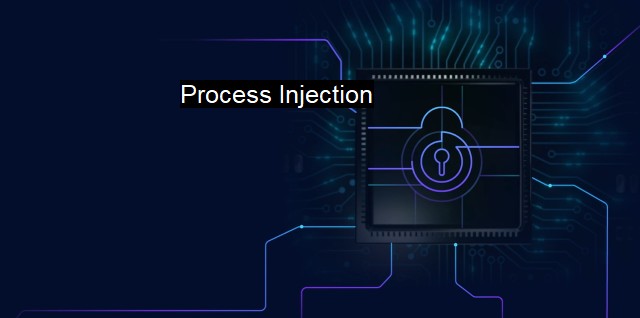What is Process Injection?
Process Injection: Understanding the Most Dangerous Cybersecurity Threat and Its Impact on Organizational Security
Process injection is a method of executing arbitrary code in the address space of a separate live process. It is a popular technique among cyber attackers and can be leveraged to bypass restrictions imposed by security programs such as antivirus software. It is accomplished by running a certain code without creating a file or a new process; thus, evading detection.Under the scope of cybersecurity and antivirus, process injection is a critical concept because it's not only difficult to detect, but it also poses a considerable threat to the integrity, confidentiality, and availability of data and systems when misused.
One common technique used in process injection is DLL injection. When employing this method, attackers create a Dynamic-link library (DLL) of malicious code and load them into a legitimate process. Attackers rely on Windows' functionality to enable loading a DLL in a remote process’s memory address space. Following this, the system calls up and executes the newly loaded DLL, obscuring the actions of the harmful code behind seemingly benign processes.
Another popular method is code injection or invasive process injection. In this case, an attacker injects code directly into a legitimate process. Manipulated in this way, the process does not behave differently to the user, containing and executing its original code combined with the malicious injected code.
It is also crucial to highlight the thread execution hijacking technique. Here, an attacker injects malicious code by hijacking threads of a legitimate process. The injected malicious thread will serve to change the path that the clean threads would normally follow, forcing them to execute the attacker’s malicious code.
Security software developers are constantly on the lookout for process injection methods and patterns to modify strategies that detect and block them, but the versatility and advancing sophistication of such methods challenge these efforts.
Antivirus software uses a multitude of techniques to counter these threats. Anomaly detection, watching for abnormal behavior in processes, is an effective technique for identifying process injections. If a process behaves irregularly — an office application is listening to network traffic, for example — the antivirus software can flag and investigate the process.
Antivirus software may also do hooking, a method where it intercepts system function calls, checking them for harmful behaviors before allowing them to execute. This technique can directly prevent many forms of process injection from being carried out.
Process hollowing monitoring is another strategy employed by cybersecurity. This is where an attacker creates a new process in a suspended state, replaces its image base with a malicious one, and resumes it. Monitoring for this behavior can prevent the execution of malicious code.
Timely patching and updates for antivirus software are also crucial protective measures from threats like process injection. Each update or patch potentially contains critical improvements in identifying and blocking new and evolving malicious methods or strategies.
Process injection is a dangerous weapon in a cyber attacker's arsenal as it enables malware execution while avoiding detection. To counter this cybersecurity threat, contemporary cybersecurity solutions - especially antivirus software - employ a variety of techniques, including systematic behavior surveillance, interception of system function calls, improving threat detection algorithms, plus consistent upgrades and updates.
The versatility and complexity of process injection and its potential to inflict colossal damage underscore the profound need for ongoing research, continual cybersecurity education, and development of even more robust protective practitioners and strategies.

Process Injection FAQs
What is process injection in cybersecurity?
Process injection is a technique used by cybercriminals to inject malicious code into a legitimate process running on a victim's computer. This technique allows attackers to bypass antivirus software and gain access to sensitive information or systems without being detected.How does process injection work?
Process injection works by hijacking a legitimate process and injecting malicious code into it. Attackers can choose a process that is already running on the victim's computer or launch a new one. Once the malicious code is injected, it can execute without arousing suspicion from antivirus software.What are some common types of process injection techniques?
Some common types of process injection techniques include DLL injection, code injection, and reflective DLL injection. In DLL injection, attackers inject malicious code into a running process by loading a malicious dynamic-link library (DLL) into the address space of the process. In code injection, attackers write malicious code directly into the memory space of a process. Reflective DLL injection is a more advanced technique that involves injecting a DLL into a process without using the traditional load library function.How can organizations protect against process injection attacks?
Organizations can protect against process injection attacks by implementing multiple layers of defense, including antivirus software, firewalls, and intrusion detection systems. They can also adopt best practices such as maintaining up-to-date software and applying regular security patches. Additionally, organizations can use endpoint detection and response (EDR) solutions that can detect and respond to process injection attacks in real-time.| | A | | | B | | | C | | | D | | | E | | | F | | | G | | | H | | | I | | | J | | | K | | | L | | | M | |
| | N | | | O | | | P | | | Q | | | R | | | S | | | T | | | U | | | V | | | W | | | X | | | Y | | | Z | |
| | 1 | | | 2 | | | 3 | | | 4 | | | 7 | | | 8 | | |||||||